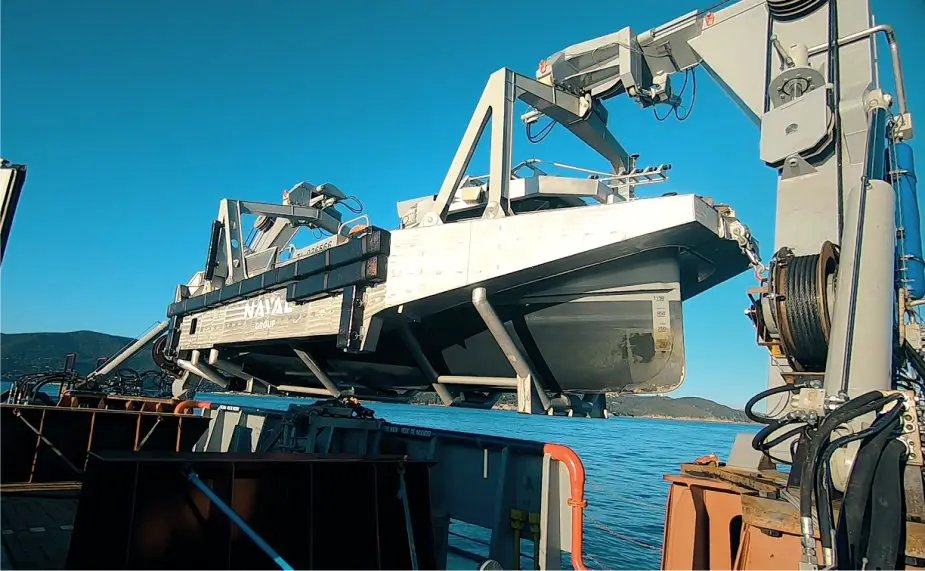Breaking news
Belgium Naval & Robotics successfully tests LARS solution.
According to a PR published by Belgium Naval & Robotics on January 20, 2022, during industrial tests conducted in Toulon, the solution for rallying, recovering, maintaining, and launching surface drones (LARS, Launch and recovery system) developed by Belgium Naval & Robotics, a Naval Group, and ECA Group consortium has demonstrated its relevance and reliability in real conditions.
Follow Navy Recognition on Google News at this link
 Launch and recovery system (LARS) and VN Rebel (Picture source: Belgium Naval & Robotics)
Launch and recovery system (LARS) and VN Rebel (Picture source: Belgium Naval & Robotics)
A demonstration of the deployment and recovery operation of the fully remotely operated USV (Unmanned Surface Vehicle) and a presentation of the test results took place in the presence of the Royal Belgian and Dutch navies as part of the rMCM (Replacement Mine Counter Measure) program.
The cooperation between the two companies combines Naval Group's ability to design a platform-integrated system that enables the safe deployment and recovery of ECA Group's USV INSPECTOR 125 surface drone.
Result of several years of engineering development, this innovative system deploys laterally on each side of the vessel. This innovation doubles the deployment and recovery capacity.
The industrial tests carried out off Toulon, mobilized up to thirty consortium employees and made it possible to test this innovative technical solution up to sea state 4/5, 40 knots of wind and by day and by night. The analysis and processing of the information collected will enable the solution to be finalized and the production of the system to be launched in the second semester of 2022.
Deploying and retrieving robotic drones provides the dual strategic advantage of extending the action capability of ships equipped with the solution, but also of protecting personnel and ships.
Thanks to the stand-off solution proposed by Belgium Naval & Robotics (detection, identification and neutralization of mines without human intervention in situ), the Belgian and Dutch naval forces will be able to rely on these drones for mine clearance operations while remaining at a safe distance.
The tests brought together for the first time four subsystems designed by the consortium and allowed them to be tested in real conditions on the VN Rebel, a specially chartered vessel:
• The LARS (Launch and Recovery System): equipped with automated arms that equip the two sides of the ships, it works like an elevator, allowing the launching and recovery of the floating dock that hosts the drones;
• The floating dock: a "cradle" for hosting surface drones (USV). This particularly innovative system makes it possible to limit the swing phenomena by working in a combined and automated way with the kinematics of the gantry combining guide arms, winches and a synchronized system of absorption. The floating dock allows to limit the overall efforts while guaranteeing overall stability. Once lifted on board, the dock allows maintenance and reconfiguration of the USV without having to move it.
• The security system: allows the drones to be locked in the floating dock. A real asset, securing the drones in their dock limits the need to move them for reconfiguration and maintenance, thus simplifying operations while protecting personnel from the risks inherent
in handling;
• The drone: ECA Group's USV INSPECTOR 125 allows the deployment and recovery of:
▪ An A-18 underwater drone, carrying the UMISAS synthetic interferometric side scan sonar for mine detection;
▪ A T-18 towed sonar, carrying the UMISAS synthetic interferometric side scan sonar for mine detection;
▪ A SEASCAN underwater drone for mine identification;
▪ A K-STER C underwater drone for mine neutralization;
▪ An influence mine sweep integrating magnetic, electric and acoustic modules
The twelve ships (MCMPF) ordered by the Belgian and Dutch navies will be equipped with twentyfour of this innovative and now, proven solution. The first of class rMCM was laid down by Naval Group in Concarneau the 30th of November 2021.
These mine countermeasures vessels, capable of withstanding underwater explosions and equipped with low acoustic, electrical and magnetic signatures, will be delivered between 2024 and 2030 to Zeebrugge, Belgium. They will be the first dedicated drone carriers in naval history, equipped to operate a fully robotic drone system for mine detection, classification and neutralization.





























